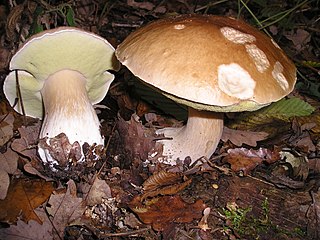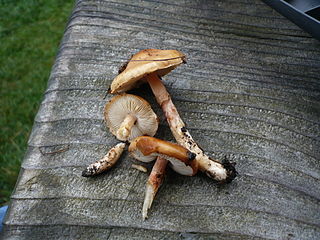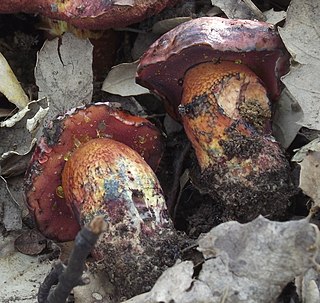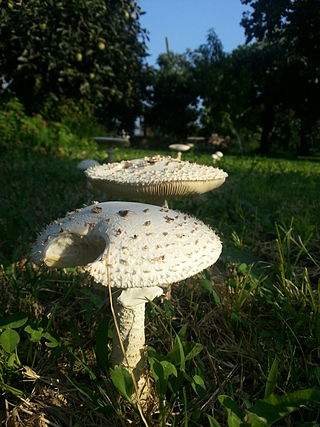
The Boletaceae are a family of mushroom-forming fungi, primarily characterised by small pores on the spore-bearing hymenial surface, instead of gills as are found in most agarics. Nearly as widely distributed as the agarics, the family is renowned for hosting some prime edible species highly sought after by mushroom hunters worldwide, such as the cep or king bolete . A number of rare or threatened species are also present in the family, that have become the focus of increasing conservation concerns. As a whole, the typical members of the family are commonly known as boletes.

Limacella is a genus of mushroom-forming fungi in the family Amanitaceae in order Agaricales. Some of the species have been classified as members of genus Lepiota. Limacella was described by mycologist Franklin Sumner Earle in 1909.

The Polyporaceae are a family of poroid fungi belonging to the Basidiomycota. The flesh of their fruit bodies varies from soft to very tough. Most members of this family have their hymenium in vertical pores on the underside of the caps, but some of them have gills or gill-like structures. Many species are brackets, but others have a definite stipe – for example, Polyporus badius.
Catatrama is a fungal genus in the family Amanitaceae, order Agaricales. Originally a monotypic genus with Catatrama costaricensis, found in Quercus pilarius forest in Costa Rica. In 2007, the species was reported from Brazil. Since then 2 additional species, one from Australia and one from India have been recognized.

Rubroboletus rhodoxanthus is a species of bolete in the family Boletaceae, native to Europe. Previously known as Boletus rhodoxanthus, it was transferred in 2014 to the newly erected genus Rubroboletus, based on DNA data.

Exsudoporus permagnificus is a species of bolete fungus in the family Boletaceae, native to Southern Europe and Western Asia. Described as new to science in 1981, the fungus was originally placed in genus Boletus. Following molecular studies outlining a new phylogenetic framework for Boletaceae, the fungus was transferred to the newly erected genus Exsudoporus in 2014, to which it is the type species. Nevertheless, Wu and colleagues (2016) were reluctant to accept the newly proposed genus due to a lack of sufficient sequences and regarded it a synonym of Butyriboletus. Following studies reinstated the status of Exsudoporus as a monophyletic genus sister to Butyriboletus, following additional collections and extended phylogenetic and morphological analyses.
Butyriboletus peckii is a fungus of the genus Butyriboletus native to eastern North America. It was first described by Charles Christopher Frost in 1878. Until 2014, it was known as Boletus peckii. Recent changes in the phylogenetic framework of the Boletaceae prompted the transfer of this species, along with several other related boletes, including Caloboletus calopus, to the genus Caloboletus. In 2015, Kuan Zhao and colleagues published analysis that demonstrated that the bolete belongs to Butyriboletus, closely related to Butyriboletus pulchriceps.

Exsudoporus is a genus of fungi in the family Boletaceae. It was circumscribed in 2014 by Alfredo Vizzini and colleagues, following a number of molecular studies that outlined a new phylogenetic framework for Boletaceae and revealed the genus Boletus in its traditional circumscription to be polyphyletic. However, due to lack of sufficient sequences, Wu and colleagues (2016) were reluctant to accept the newly proposed genus and considered it a synonym of Butyriboletus. Following additional phylogenetic sequencing and morphological analyses, Exsudoporus was clearly resolved as a monophyletic, homogenous and independent genus that is sister to Butyriboletus.

Pseudoaustroboletus is a fungal genus in the family Boletaceae. The genus is monotypic, containing the single species Pseudoaustroboletus valens, found in China, Japan, Malaysia and Singapore. It was originally given the name Boletus albellus illegitimately based on specimens from Singapore by George Edward Massee in 1909. In 1972 it was given the name Boletus valens legitimately before being transferred to Tylopilus valens in 1976. A molecular phylogenetics study found it to be distinct from Tylopilus and Boletus and the authors placed it in its own genus, Pseudoaustroboletus.

The genus Saproamanita contains about 24 species of agarics and is one of six genera in the family Amanitaceae, of which the similar Amanita is also a member. Saproamanita differs from Amanita in that its species are saprophytic, and not ectomycorrhizal.
Amanita pallidorosea is a deadly poisonous mushroom of the large genus Amanita, closely related to A. bisporiga. It occurs in China under beech trees.
Amanita subfuliginea is a mushroom of the large genus Amanita, which occurs central and southern China. It is closely related to the east Asian death cap A. fuliginea.
Amanita griseorosea is a mushroom of the large genus Amanita, which occurs under beech in southern China. It is closely related to A. molliuscula.
Amanita molliuscula is a mushroom of the large genus Amanita, which occurs under beech in Shaanxi Province in China. It is closely related to A. griseorosea.
Amanita parviexitialis is a mushroom of the large genus Amanita, which occurs under beech in southern China.
Sutorius magnificus, known until 2014 as Boletus magnificus, is a species of bolete fungus in the family Boletaceae native to Yunnan province in China. It was transferred to the new genus Neoboletus in 2014, and then Sutorius in 2016.
Limacellopsis is a genus of mushroom-forming fungi in the family Amanitaceae in order Agaricales. Analysis of DNA sequences was used to show that Limacellopsis was separate from Limacella which is similar in appearance. The name Limacellopsis means like-Limacella.

Mariannaea is a genus of fungi belonging to the family Nectriaceae.

Amanita orientigemmata, is a species of agaric fungus in the family Amanitaceae native to northeastern, northwestern and southern China, India and Japan, first described by Zhu L. Yang & Yoshimichi Doi in 1999.

Zhuliangomyces illinitus is a mushroom-forming fungus species of genus Zhuliangomyces in the family Amanitaceae in the order Agaricales. It has been known most recently as Limacella illinita. Also known previously as Agaricus illinitus and Mastocephalus illinitus. This fungus is known for its distinctive slimy cap. Z. illinitus is commonly known as the dripping slimecap or the overflowing slimy stem.










